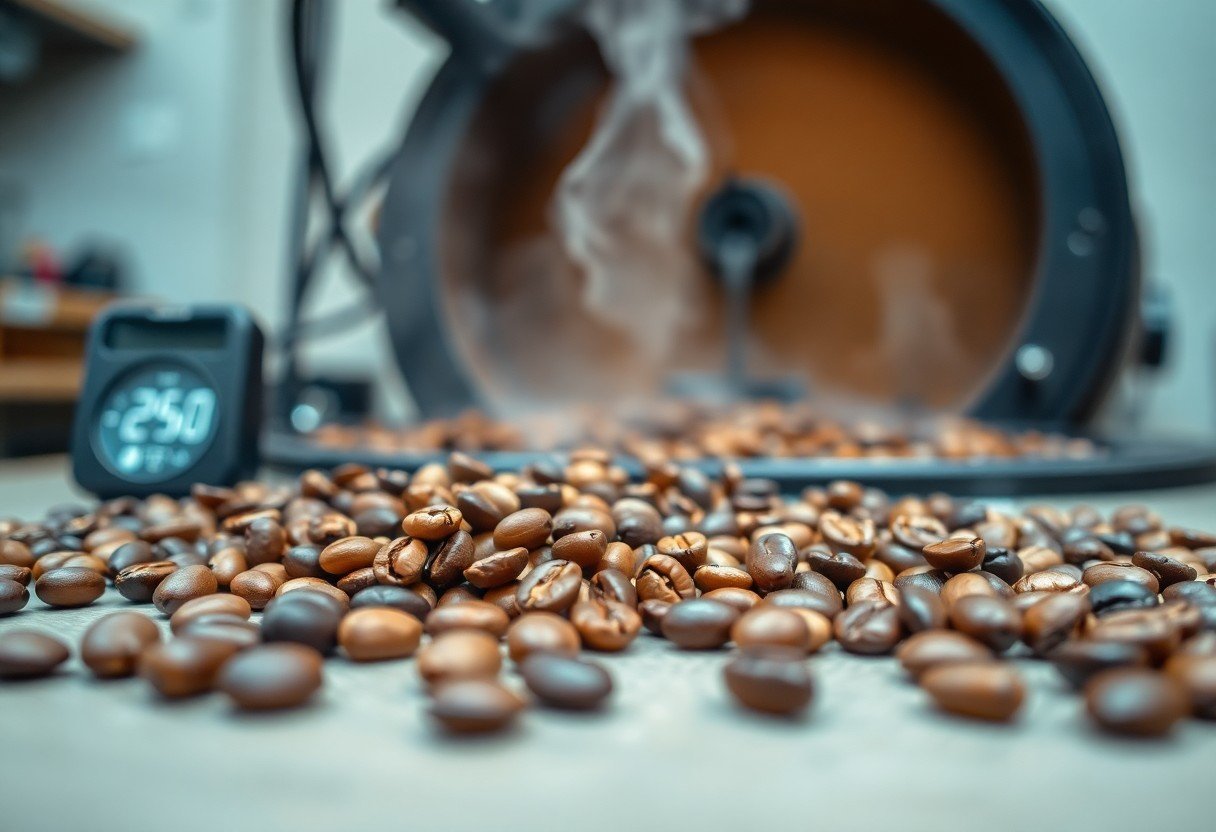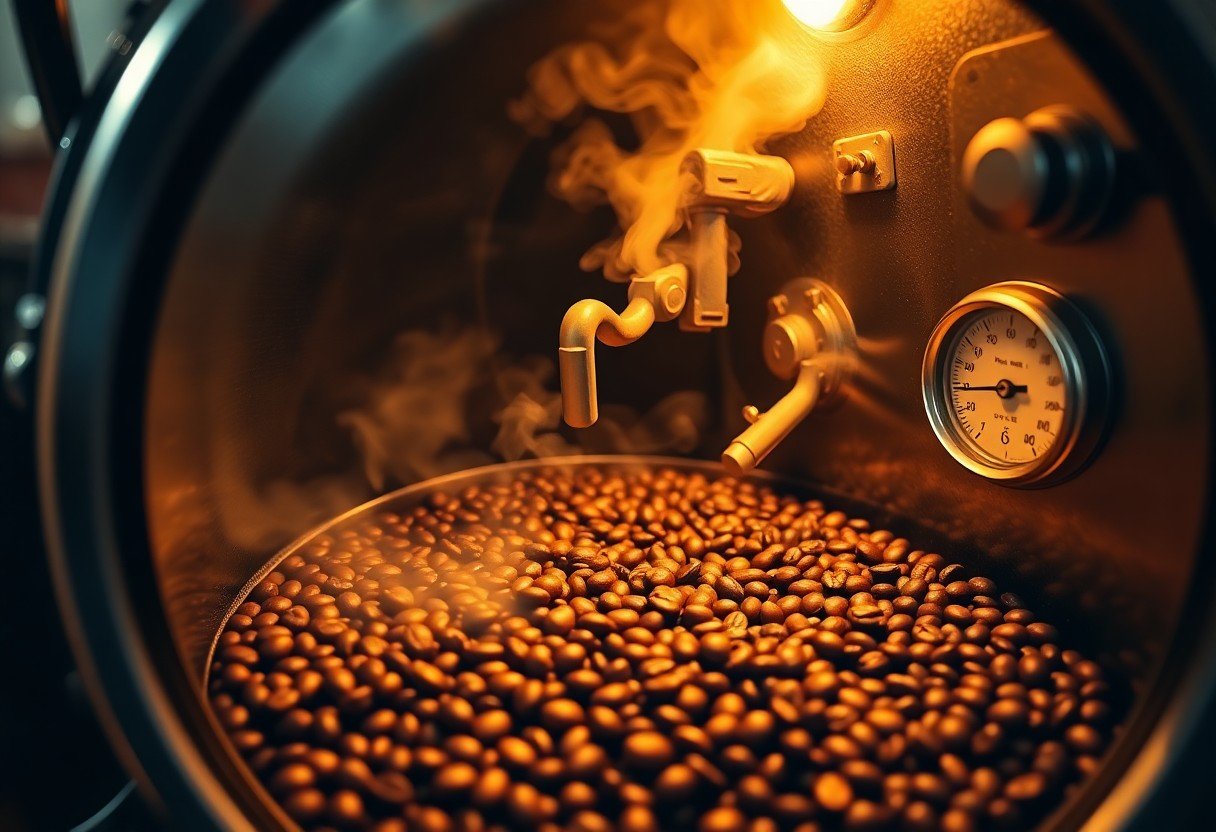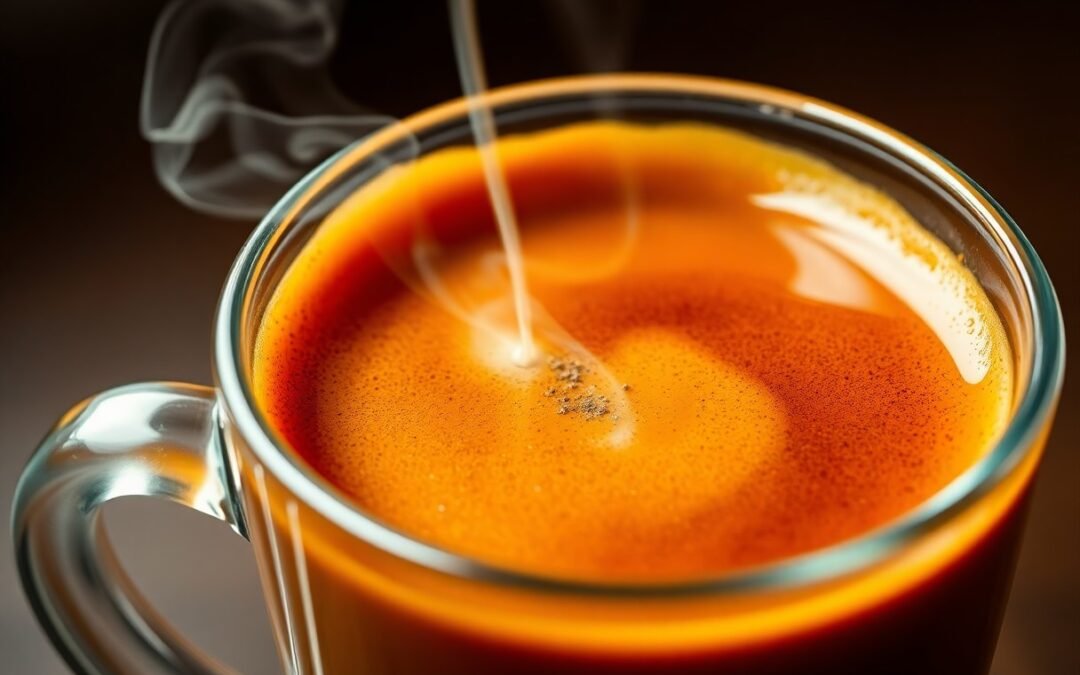Alchemy plays a significant role in transforming raw coffee beans into the delightful aroma and rich flavors you experience in your cup. The Maillard reaction, a complex series of chemical reactions that occur during roasting, is key to developing coffee’s unique characteristics. By understanding this process, you can enhance your appreciation for the intricate flavors and aromas that define your favorite brews, enriching your overall coffee experience.
The Science Behind Flavor Development
Flavor in coffee emerges from complex interactions during roasting, where heat triggers a cascade of chemical reactions. Understanding these processes reveals how various compounds influence taste, aroma, and sensory experience. When you explore coffee flavor, you investigate into a world shaped by science, where the balance of sweetness, bitterness, and acidity intertwine to create your perfect cup.
Maillard Reactions Explained
The Maillard reaction forms when amino acids and reducing sugars react under heat, crafting rich flavors and brown pigments. In coffee roasting, at around 140°C (284°F), this reaction kicks in, producing hundreds of volatile compounds that enhance aroma and complexity. You can taste these transformations distinctly, as they shift from grassy notes in green beans to deep chocolate and caramel in the final brew.
Key Chemical Transformations in Coffee Processing
During coffee processing, several significant transformations take place, including caramelization and the degradation of chlorogenic acids. These alterations are critical in developing your beverage’s profile, influencing bitterness and acidity levels distinctly. Temperature, time, and moisture control during roasting significantly contribute to these changes, leading to a spectrum of flavors tailored to various preferences.
The transformation of chlorogenic acids into quinic and caffeic acid during roasting is particularly noteworthy. As roasting progresses, these compounds degrade, resulting in increased solubility and, consequently, a more refined flavor profile. Caramelization further elevates sweetness levels, while the controlled application of heat allows for optimal extraction, enhancing the smoothness and overall enjoyment of coffee. The interplay of these chemical changes not only defines the essence of your brew but also showcases the art and science behind crafting the perfect cup.

The Role of Temperature and Time in Coffee Roasting
| Temperature | Higher temperatures accelerate the Maillard reactions, producing richer flavors and aromas, while lower temperatures may yield milder, more acidic notes. |
| Time | Longer roasting times allow for deeper flavor development, but excessive duration can lead to burnt tastes, reducing the complexity of the cup. |
How Heat Alters the Flavor Profile
Heat acts as a catalyst in coffee roasting, significantly shaping your beverage’s flavor profile. Increasing temperatures promote the breakdown of sugars and amino acids, facilitating the Maillard reaction, which yields a spectrum of flavors from nutty and chocolatey to caramelized. As your beans roast, a delicate balance emerges, transforming initially grassy flavors into the complex, rich notes you savor in a well-brewed cup.
The Impact of Roasting Duration on Maillard Reactions
Roasting duration plays a vital role in enhancing the Maillard reactions, directly influencing the flavor complexity and aroma of your coffee. Longer roasting times allow for extensive reactions between sugars and amino acids, resulting in a more pronounced depth of flavor. The intricate balance of heat and time ensures your beans develop a desirable profile—too brief a roast may leave sourness, while excessive duration can introduce burnt flavors.
When considering the impact of roasting duration, factors like bean origin and desired roast level must be taken into account. For instance, light roasts generally highlight floral and fruit characteristics but require precise timing to prevent the sugars from caramelizing too soon. Conversely, medium and dark roasts demand longer durations to enable full flavor development, promoting richer, bolder profiles. Evaluating how long you roast can fundamentally alter the coffee experience, transforming your morning ritual into a sensory adventure.
From Bean to Brew: The Journey of Coffee Flavor
Your coffee’s flavor journey starts long before it reaches your cup. Each stage, from cultivation to roasting, contributes richly to the final taste. The transformation involves chemical reactions, notably Maillard, that create complex flavor compounds. The type of beans, their origins, and the roasting process all intertwine to produce a myriad of flavor profiles. As you explore different beans and brews, each cup unveils new notes, aromas, and sensations that reflect the intricate journey taken from bean to brew.
Influence of Bean Origin on Maillard Outcomes
The origin of your coffee beans significantly influences the outcomes of Maillard reactions. Beans sourced from regions like Ethiopia often carry distinct floral and fruity notes, while those from Brazil may present nutty undertones. The climate, soil, and altitude of the growing region all factor into the complexity of flavors produced during roasting. Each origin contributes unique characteristics that can alter how the Maillard reaction amplifies or suppresses specific flavors, ultimately shaping your coffee experience.
Impact of Brewing Techniques on Flavor Extraction
Your brewing technique plays a pivotal role in flavor extraction, determining the balance of acidity, sweetness, and body in your cup. Methods such as pour-over, French press, and espresso each manipulate water temperature, pressure, and time, affecting how flavors are released from the coffee grounds. For instance, a longer steeping time in a French press allows for increased extraction of oils and solubles, enhancing the body and richness of the coffee. Choosing the right technique offers you a pathway to achieving your desired flavor profile.
The Intersection of Chemistry and Sensory Experience
Delving into the sensory dimensions of coffee reveals how chemistry intricately shapes what you perceive. Maillard reactions, occurring during roasting, unlock a tapestry of flavors and aromas that engage your senses, transforming mere beans into a rich sensory experience. Your palate interprets these compounds, triggering memories and emotions linked to distinct aromas, taste profiles, and even textures, precision-tuning your coffee enjoyment.
How Maillard Reactions Shape Aroma and Taste
The Maillard reactions produce an astonishing array of volatile compounds during coffee roasting, significantly impacting aroma and taste. As sugars and amino acids undergo complex transformations, they generate hundreds of flavor compounds, such as furans and carbonyls. These components work together to create the rich, roasted notes you savor in your cup, from nutty undertones to chocolatey richness, exemplifying the beauty of chemistry at work.
The Psychophysics of Coffee Flavor Perception
Your perception of coffee flavor relies heavily on how your senses interpret complex chemical interactions. The brain integrates signals from taste receptors and olfactory cues to form a cohesive flavor profile. Factors like temperature, acidity, and aroma intensity all contribute to how you experience coffee, often making the same type of brew taste dramatically different under varying conditions.
In studies of psychophysics, researchers have quantified how sensory modalities interact with chemical stimuli to influence flavor perception. For instance, the interplay of aroma and taste can amplify your overall experience, with aromas often perceived more intensely than tastes alone. Sensory memory also plays a role; familiar aromas can evoke specific memories, enhancing your engagement with the coffee. Additionally, variations in temperature can alter your taste sensitivity, where a hotter brew might emphasize bitterness, transforming your enjoyment of each sip. Understanding these interactions deepens your appreciation of coffee, revealing it as a complex sensory tapestry shaped by both chemistry and cognition.

Innovations in Coffee Production and Preparation
Advancements in coffee production and preparation are continuously shaping the beverage’s flavor profile, ensuring your daily cup is not only enjoyable but also a sensory experience. Techniques such as precision fermentation and improved processing methods are now standard, enhancing the inherent flavors of beans. Each step, from meticulous harvesting to innovative extraction techniques, serves to maximize taste and aroma, allowing you to explore a wider variety of flavor notes in your coffee.
Cutting-Edge Techniques Enhancing Flavor Creation
Modern techniques like vacuum drying and controlled fermentation are revolutionizing how you experience coffee’s flavors. By manipulating variables like temperature and humidity, these methods intensify the complex profiles that develop during processing. You can taste the difference as these innovations yield brighter acidity and deeper sweetness, transforming your coffee into a more vibrant experience that reflects its unique origin.
Trends Influencing the Future of Coffee Flavor Profiles
The future of coffee flavor profiles is being sculpted by trends prioritizing sustainability, transparency, and unique sensory experiences. These drivers allow you to connect more deeply with your coffee, as producers focus on terroir and responsible sourcing practices. The rise of experimental roasts and the exploration of diverse varietals promise an exciting array of taste experiences for coffee drinkers.
Focusing on sustainability, coffee producers are increasingly embracing regenerative agriculture, which not only enhances bean quality but also contributes to environmental health. As you seek out exceptional coffee experiences, you may notice a growing availability of unique varietals from regions previously overlooked. Additionally, collaborative efforts between growers and roasters are creating innovative blends and single-origin coffees, allowing you to explore an ever-expanding universe of flavors that celebrate both craftsmanship and the sustainability movement.
Final Words
The alchemy of Maillard reactions is imperative to sculpting coffee’s essence, transforming green beans into aromatic brews that delight your senses. As you explore different roasting stages, you witness how temperature and time elicit complex flavors and rich aromas, enhancing your overall coffee experience. Understanding this process allows you to appreciate the intricate chemistry behind each cup, elevating your enjoyment and choice in coffee selections. Ultimately, you gain a deeper connection to your favorite beverage, recognizing the artistry behind every sip.
FAQ
Q: What is the Maillard reaction in coffee?
A: The Maillard reaction is a complex chemical process that occurs during the roasting of coffee beans, where amino acids and sugars interact, leading to the development of rich flavors, aromas, and colors characteristic of brewed coffee.
Q: How does roasting time affect the Maillard reaction in coffee?
A: Longer roasting times intensify the Maillard reaction, resulting in deeper flavors and darker colors, while shorter roasting times preserve lighter flavors and acidity.
Q: Why is the temperature important in the Maillard reaction?
A: Temperature significantly influences the rate of the Maillard reaction; higher temperatures accelerate the process, enhancing flavor development, while lower temperatures may result in incomplete reactions and muted flavors.
Q: What flavor compounds are produced from the Maillard reaction in coffee?
A: The Maillard reaction generates a range of flavor compounds, including caramel, nutty, and chocolate notes, contributing to the complexity and depth of coffee’s overall taste profile.
Q: Can the Maillard reaction be controlled during coffee brewing?
A: While the Maillard reaction primarily occurs during roasting, factors such as brewing temperature, time, and water chemistry can influence the extraction of flavor compounds during brewing, thus affecting the final taste.

